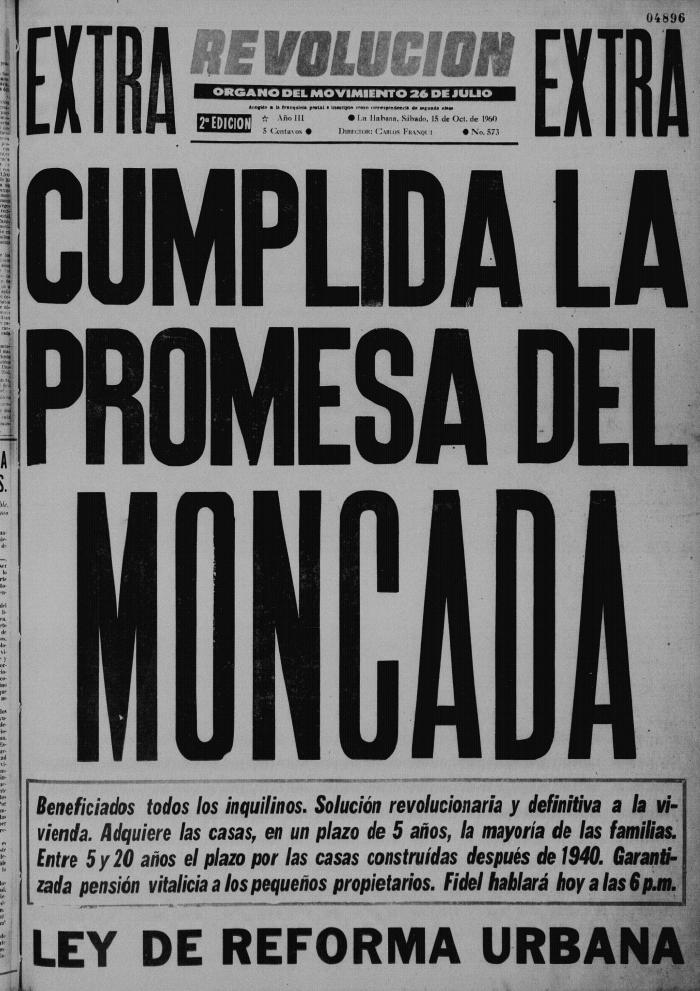
Over the course of two days, October 13-14, the revolutionary Council of Ministers held a historic meeting in which important laws were approved. After the signing of Nationalization Laws 890 and 891, at 1:45am October 14, the body was recessed, to reconvene later in the afternoon. During this second session, the Law of Urban Reform, as well as the Law of Land Lots and Country Estates, were approved.
URBAN REFORM OF GREAT IMPORTANCE
With the signing of the Law of Urban Reform, the government declared to the Cuban people, and the world, that the Cuban Revolution had implemented the Moncada program, outlined by Fidel in his historic 1953 defense, known as “History will absolve me.” At that time, he emphasized six points, which addressed the country’s principal problems, toward which he proposed directing all of the Revolution’s efforts once democratic liberties were won. These were the problems of land, industrialization, housing, employment, education and health.
In a special “Meet the Press” television program, on the afternoon of October 15, Fidel discussed the meaning and essence of the laws approved 22 months after the triumph of the Revolution, saying, “The Law of Urban Reform was conceived in the Moncada era. Moreover, it is the only point left (to be addressed) from the Moncada program. Thus it has its origins in that era […] the fundamental principle is that this law makes renters the proprietors of their homes. Why? Because in reality renters are paying for 15, 20, 25, years… There are families that have been paying for their houses for 30 years... They have paid for the house many times over. Yet they are never the owner of the house. [1]
In his extensive remarks, Fidel described those October days as historic, since so much of the Moncada program was being implemented, which, he said, “has been the document that has guided the government, the principles which guide the conduct of the Revolutionary government at this time.”
Also constituted on October 14 was the National Literacy Commission, which would prepare the way and lead the country’s campaign to eliminate illiteracy, a battle won in 1961.
A NEW PROGRAM FOR THE REVOLUTION
On that Saturday, October 15, before explaining the importance of the newly approved Urban Reform Law, Fidel emphasized that given the accelerating pace of actions taken by the United States against Cuba, the Revolution was facing a decisive moment which required great effort, since the fundamental debate between the people’s dreams and those of the enemy were at odds, “The first,” he said, “want to see their ideals realized; the second want to crush the Revolution.”
The approval of these laws, he stated, represented the end of a fundamental, decisive stage of the Revolution, and that a new one would now begin. The government had fulfilled the Moncada program, and in many ways had gone farther, he said.
Fidel informed the people that, as of this moment, another historic document would guide the Revolution, saying, “We are entering a new stage; the methods are different; our principles are now synthesized in the Declaration of Havana.” [2]
With the popular democratic, agricultural, and anti-imperialist stage completed, as of October 15, 1960, the Declaration of Havana approved a few weeks earlier by the Cuban people, September 2, 1960, would become the Cuban Revolution’s program of struggle.
The Declaration of Havana was undoubtedly the antecedent to the proclamation of the socialist character of the Revolution, April 16, 1961. Fidel recognized this in an article written in September of 1961 for the first issue of the magazine Cuba Socialista, “The Revolution didn’t become socialist that day. It was socialist in its expressed will, and in its aspirations, when the people made the Declaration of Havana.”
[1] Revolución, October 17, 1960, Havana, p. 10.
[2] Ibidem.















